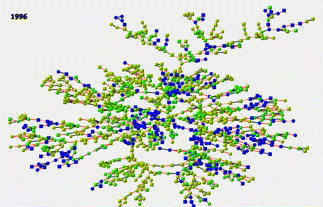Here is some really interesting research from James Fowler (UC San Diego) and Nicholas Christakis (Harvard) on happiness and social networks. The question was whether one’s network of friends and relatives has a major affect on their happiness. Does having happy friends and relatives tend to make a person happy? And, conversly, does having unhappy people around you make you unhappy. The answer is a clear “yes.”

Consider the figure included here which shows one social network of people and their ties (connections). Nodes colored yellow represent happy people, while nodes color blue represent unhappy people (green nodes are intermediate). It is clear that happy and unhappy people cluster together.
Not only are the results interesting, but the methodology of social network analysis is also noteworthy. I like how the authors used simulation techniques to measure whether the patterns observed in the networks differed significantly from what would have occured by chance alone. They also did a good job of trying to separate out multiple influences, such as the types of relationships, the effects of physical and social distance, etc.
Clusters of happy and unhappy people are visible in the network, and the relationship between people’s happiness extends up to three degrees of separation (for example, to the friends of one’s friends’ friends). People who are surrounded by many happy people and those who are central in the network are more likely to become happy in the future. Longitudinal statistical models suggest that clusters of happiness result from the spread of happiness and not just a tendency for people to associate with similar individuals. A friend who lives within a mile (about 1.6 km) and who becomes happy increases the probability that a person is happy by 25% (95% confidence interval 1% to 57%). Similar effects are seen in coresident spouses (8%, 0.2% to 16%), siblings who live within a mile (14%, 1% to 28%), and next door neighbours (34%, 7% to 70%). Effects are not seen between coworkers. The effect decays with time and with geographical separation.
Citation:Fowler, J.H., & Christaki, N.A. (2008). Dynamic spread of happiness in a large social network: Longitudinal analysis over 20 years in the Framingham Heart Study. BMJ (British Medical Journal) 2008;337:a2338
